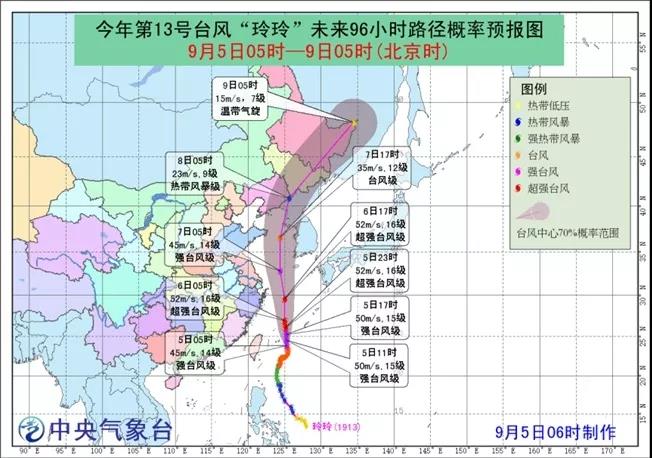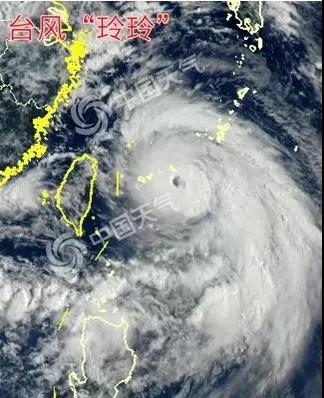Three days from today, the typhoon "Ling Ling" in the north will gradually bring wind and rain to the coastal areas of Northeast China and the northeast. Zhejiang, Shanghai, Jiangsu and Northeast China should pay close attention to the future development of the typhoon “Lingling” and do a good job in defense.

The National Meteorological Impact Forecast and Assessment issued by the Central Meteorological Observatory on September 4th shows that the typhoon “Lingling” will bring great wind and rain to the eastern coastal areas of southern South China, and the production of agriculture, forestry and fishery must be strengthened.

First, the typhoon "Lingling" will bring more severe weather to the south of South China and the eastern part of the south of the Yangtze River. There may be heavy rainfall in the eastern part of the Northeast.
The 13th typhoon "Ling Ling" was strengthened from the strong tropical storm level to the typhoon level on the evening of September 3. At 11 o'clock on the 4th, its center is located on the east side of Taiwan, about 390 kilometers southeast of Yilan County, Taiwan Province of China. The north latitude is 22.3 degrees and the east longitude is 124.5 degrees. The maximum wind force near the center is 12 (35 m/s), and the central minimum pressure is 970 hectopascals.
It is expected that the typhoon "Lingling" will first circulate, and then move to the northeast and northward at a speed of about 10 kilometers per hour. The intensity will gradually increase. On the 5th, it will enter the southern part of the East China Sea. The maximum intensity can reach the strong typhoon level or super typhoon level. (14-16, 45~52 m/s), will enter the southern part of the Yellow Sea on the 7th, and then the intensity will gradually weaken. Affected by the typhoon “Lingling” and the tropical low-pressure and monsoon trough systems, it is expected that there will be large wind and rain weather in the southern coastal areas of southern China, the eastern coastal areas of the south of the Yangtze River, and the eastern part of the northeastern region. On the 4th to 5th, there were heavy rains in some areas of South China's coastal areas, and there were heavy rains on the local area. On the 6th, there were heavy rains in parts of eastern Jiangsu, southeastern Fujian, southern Guangdong, central and eastern Hainan Island, southern part of Taiwan Island, and Liaodong Peninsula and Shandong. In the peninsula, central Jiangsu, southern Shanghai, central Zhejiang, central Guangdong, northeastern Hainan Island, southern part of Taiwan Island, etc., there are 4 to 6 and above 6 strong winds; 7-8 days, there is heavy rain in the eastern part of Northeast China. In some areas, there are heavy rains and heavy rains.
Second, impact and recommendations
The heavy rainfall and windy weather brought by the typhoon easily lead to floods and windstorms in some of the above-mentioned areas, causing flooding of farmland, lodging of high-altitude crops such as corn, collapse of agricultural facilities, and wind and rain, which may lead to economic fruit and fruit stalks breaking. And damage to the aquaculture pond. Suggest:
The coastal areas of South China affected by the typhoon and the eastern coastal areas of the south of the Yangtze River must pay attention to the management of farmland and orchard, prevent waterlogging disasters, harvest mature fruits in time, and pay attention to strengthening agricultural and fishery facilities to prevent collapse and damage, and avoid or mitigate losses.
The heavy rainfall brought by the typhoon will aggravate the wetland condition of the farmland in the eastern part of Northeast China, which is not conducive to crop filling and milk ripening. The development period of some growing seasons may be further delayed. It is recommended to dredge the ditch early and promptly drain after rain. The crop is normally grouted.
Emergency deployment of defense work in the Ministry of Agriculture and Rural Affairs
The Ministry of Agriculture and Rural Affairs attaches great importance to the urgent deployment of the typhoon “Lingling” defense work, and requires the agricultural and rural sectors in Inner Mongolia, Liaoning, Jilin, Heilongjiang and other places to effectively carry out typhoon defense and post-disaster production recovery to ensure the safety of agricultural production and people's lives and property.
Pay close attention to the implementation of responsibility. At present, the key period of corn, rice grouting and ripening of soybeans in Northeast China is also an important period for animal husbandry and fishery production. The strong wind and rain weather brought by typhoon “Lingling” lasts for a long time, strong wind and large rainfall, affecting the area. Overlapping with “Litchma” and “Rosa” will have a negative impact on agricultural production. The agricultural and rural departments at all levels must unswervingly stabilize the goal of increasing grain revenue, base themselves on disaster-resistance and harvest, and consciously take "Lingling" as the current urgent task, act quickly, strengthen leadership, clarify responsibilities, deploy early, and implement and ensure responsibility. When people and measures are in place, the impact of disasters can be effectively mitigated.
Strengthen monitoring and early warning. Strengthen consultations with relevant departments such as meteorology, water conservancy, emergency, and marine, do a good job in emergency, keep a close eye on the moving path of Lingling, pay close attention to the development of disasters, and make full use of media such as radio, television, newspapers, mobile phones, and the Internet. Issue warning information and prevent typhoon technical measures. Strengthen the disaster situation dispatch, collect, verify and reflect the disaster situation in time to ensure the smooth flow of information. The first time, the disaster warning information will be notified to the fishing vessels and personnel in the relevant areas, and the defense preparations such as the arrival of the fishing boats, the withdrawal of fishermen from the shore, and the standby of the fishery vessels will be reported in a timely manner.
Promote scientific disaster prevention. Grasp and strengthen agricultural production facilities such as fruit trees, greenhouses and livestock and poultry pens, and timely clear and clear the drainage system of field ditches and livestock farms to prevent large-scale internal sputum. Immediately mobilize relevant regional fishing vessels and aquaculture personnel to return to Hong Kong as soon as possible or to avoid wind and waves, and to strengthen and maintain fishing port facilities and dams as early as possible to ensure the safety of personnel. Guide agricultural enterprises, schools, hospitals and other units to do relevant prevention work.
Do a good job in production recovery. Organize experts to scientifically assess the impact of disasters, strengthen classification guidance, and implement disaster prevention and relief measures according to local conditions. Increase the input of machinery and manpower, and remove the stains in time. For the lodging of corn, it is necessary to timely support the plant to promote ventilation, spray the foliar fertilizer to accelerate the maturity, spray the fungicide to prevent disease and ear rot. If the lodging is serious, grab it as soon as possible and use it as much as possible for fresh food, processing or silage. For flooded rice, it is necessary to strengthen the management of fertilizer and water and promote normal growth and development. Do a good job in the distribution of fertilizers, pesticides, vaccines and other production materials. We will do a good job in technical guidance for the transportation and production of livestock and poultry breeding stocks for affected livestock farms. Repair ports, dams, fishing boats, fish ponds and breeding facilities damaged by typhoons as soon as possible to help farmers replenish the washed fish fry in time and resume production as soon as possible. Strengthen the prevention and control of animal diseases and the monitoring and control of crop diseases and insect pests in the disaster areas, and do a good job of post-disaster disinfection and harmless treatment of dead animals to prevent major animal diseases, zoonotic diseases and crop diseases and insect pests. Supervise and urge the relevant insurance institutions to damage and claim damages to the insured fishing vessels and other facilities and crops as soon as possible.
Contact: Mr. Ma
Phone: +86-0374-5699688
Tel: +86-0374-5699688
Email: [email protected]
Add: Fine Chemical Industry Park, Jianan District, Xuchang, Henan, China